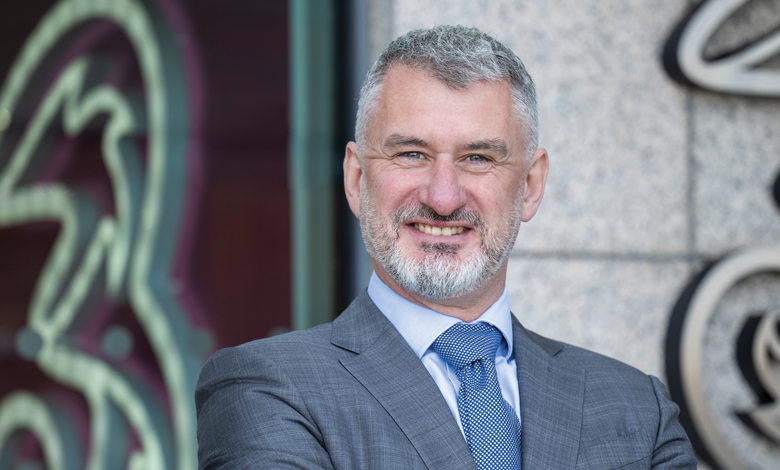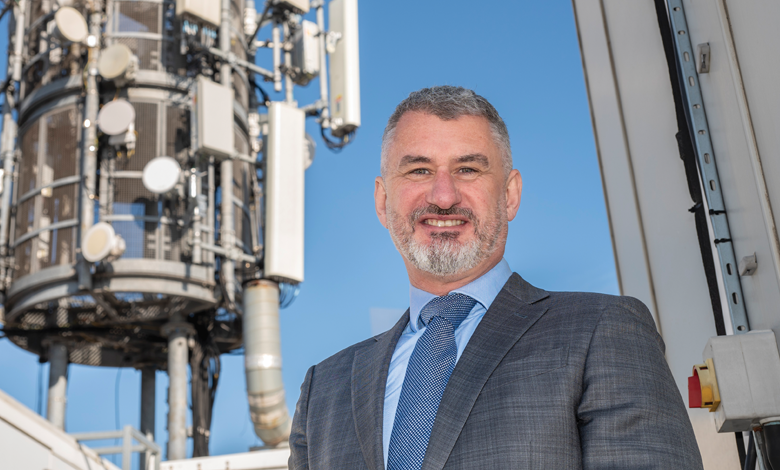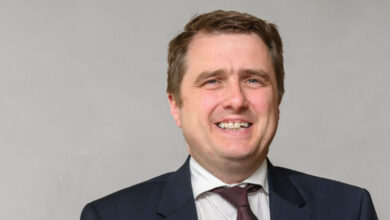Connectivity anytime, anyplace

Three Ireland’s Head of Public Sector Sales, Ken McGrath, sits down with eolas Magazine to discuss digital transformation, customer service, and his organisation’s suite of solutions for public services.
Discussing developments in the last 12 months, McGrath places emphasis on the development of Three’s network. “In the last two years, we have observed growth in our network and, in tandem, 5G services become increasingly embedded.”
While many of the technologies which came of age during the Covid pandemic have been available in one form or another, it took a crisis for them to be optimised. “The ability to work from home has been here for decades, but it took a combination of the pandemic and the advent of 5G broadband services to prompt people to begin working in a more dynamic manner,” the Head of Public Sector Sales explains.
Digital transformation, he adds, happens in cycles. “Changing operators and the subsequent impact on business is a serious consideration for organisations. As such, it is essential to have a thorough understanding of service management requirements.
“The sales cycle varies. For SMEs it can be relatively quick, whereas for public service bodies it could be anything from 12 months to 24 months from entry into the market, defining and capturing service management requirements, getting the tender to market, undergoing board evaluation, and awarding the contract.”
Indeed, these contracts can have a timespan of between two and six years from the point that they are awarded; so selecting a strategic partner is a significant consideration. As such, trusted partnership is key, particularly for the large public sector bodies.
“Speaking with several of these public organisations the emphasis on having a strategic partner is clear; they are not merely seeking a provider; they need consistent engagement,” McGrath comments.
“Ultimately, we want to enable connection to any application, from any device, and in any location. In other words, connectivity anytime, anyplace.”
Ken McGrath, Head of Public Sector Sales, Three Ireland
In two consecutive years, Three Ireland’s customer care centre in Castletroy, Limerick has been recognised for its customer service excellence, picking up three awards at both the European Contact Centre and Customer Service Awards and the Irish Customer Contact and Shared Services Awards.
McGrath ascribes two fundamental elements to this success:
1. the strength of Three Ireland’s network; and
2. the professionalism of the customer service team itself.
Network
Today, Three Ireland is the single largest mobile telecommunications provider in the State and, as of June 2024, has a market share of 47.2 per cent equating to more than 4.7 million customers. “Our network has grown continuously in recent years,” explains McGrath, adding: “With 99 per cent 4G coverage, and over 92 per cent 5G population coverage, this network is built for data.”
According to Ookla’s Speedtest Connectivity Report for H1 2024, Three Ireland remains the market leader on performance with a median 5G download speed of 137.42 Mbps. Allied to this, Three achieved the best overall performance for 5G consistency in the market.
“Our network team understands the capacity requirements and plans in a customer-centric manner; ensuring the delivery of the best possible network experience. For example, through Covid, we understood that the concentration in urban areas was diluted into rural areas, so the network was reengineered to provide for that. Today, in terms of critical locations where people need network, we continue to deliver as required.
“Differentiating between 4G and 5G is important, but from a user perspective primacy is given to the best possible network experience. The combination of Three’s 4G and 5G together ensures the best network experience possible for our public sector customers.”
Customer service
Acknowledging that Three’s network is critical, McGrath emphasises that layered on top are the customer service agents and applications “to support customers when they need assistance most”.
“As clichéd as it might sound, it is where the rubber hits the road as far as customer experience is concerned. For instance, a major challenge we observe with public sector organisations is billing management and how it is managed proactively.
“Three Ireland has a dedicated public sector team within its customer care centre. This team scrutinises billing on behalf of customers, using the likes of robotic process automation to flag upcoming thresholds. An agent will then proactively engage with the organisation and follow up with the appropriate advice, ensuring a positive customer experience,” he illustrates.
Public procurement
Focusing on public procurement, McGrath indicates that “the Office of Government Procurement (OGP) has been very effective in driving value for money in mobile services”.
“OGP has created the Mobile Voice and Data Framework which provides for the procurement of a range of mobile voice, text, and data services for eligible public sector clients. In terms of the cost benefit analysis and ensuring value for money, the framework has been successful. Drawdowns from this framework agreement are delivered through direct drawdown or mini-competitions,” he explains.
The framework intends to facilitate public sector bodies with an annual mobile spend of €50,000 or less to acquire the optimal mobile rate by availing of procurement for government agencies under a single contract.
“In a competitive market, the chief considerations are around ensuring optimal productivity and a seamless experience, as well as the ability to respond with agility.
“For Three, this means understanding an emerging challenge before the customer does and being proactive in addressing whatever that might be before it becomes a problem. To date, under the framework, Three has achieved a customer retention rate of 100 per cent, ensuring that relationships are consolidated over many years,” the Head of Public Sector Sales reveals.
Annually, the OGP conducts a competition analysis comprising all qualifying mobile providers across customer support, network coverage, and commercial rates to determine the best provider. Following rigorous competition between the three main mobile providers in the State, Three Ireland emerged as the OGP’s preferred supplier for mobile contracts expiring between 6 March 2024 and 7 March 2025.
“We are recognised as the preferred strategic partner for the delivery of mobile services for the public sector in Ireland.”
Sustainability
There are also several ESG considerations in the OGP framework. These include:
• WEEE registration and REPAK membership for framework members;
• renewable energy mobile networks;
• low-carbon fleets;
• recycled and recyclable packaging; and
• equipment with green features.
“Government is scrutinising those kind of statistics and data points, examining its supply chain in terms of how it is contributing to sectoral emissions ceilings, carbon budgets, and the national climate objectives.
“As such, it is something that we are very conscious of, especially in the context of EU directives. Fundamentally, considering our own supply chain, we must ask: ‘What are we doing in terms of decarbonisation?’ Likewise, in terms of fleet management, all of Three’s sales teams have moved to electric vehicles. Overall, sustainability is a major consideration for us,” McGrath determines.
Local government
In specific segments of the market, such as local government, Three is observing significant growth. For instance, most of the largest councils in the State – Dublin City Council, Dún Laoghaire-Rathdown County Council, Cork City and County councils, Limerick City and County Council, and Waterford City and County Council – are investing with Three Ireland.
“We are observing a migration from legacy network infrastructure, such as the public switched telephone network, and copper infrastructure which is approaching end of life,” he says, adding: “Take, for instance, traffic management systems. Migrating to new infrastructure had previously been relatively cost prohibitive. Today, migrating from legacy to new infrastructure via Three Ireland’s 5G footprint and IoT infrastructure is a lot more seamless and cost effective.”
Central government
Simultaneously, in the last 12 months, Three has had “much success” winning contracts across central government, from the Department of Education to the Department of Tourism, Culture, Arts, Gaeltacht, Sport and Media.
“Government departments have a distributed network – they have locations around the country and a geographically dispersed workforce – and Three Ireland has been able to deliver connected solutions for them.
“As our combined 4G and 5G network matures, Three delivers a seamless connected experience. Ultimately, we want to enable connection to any application, from any device, and in any location. In other words, connectivity anytime, anyplace,” the Head of Public Sector sales asserts.
Cybersecurity
In 2020, Three Ireland partnered with Corrata to launch 3Mobile Protect – a mobile threat defence solution for mobile devices and tablets – to protect its clients in the public sector.
“Often, we see organisations using mobile device management software in implementing cybersecurity policy across their infrastructure. However, this does not provide the full, end-to-end, end-point protection required on public sector body devices. 3Mobile Protect has the sophistication to recognise the attempts of bad actions attempting to compromise a device, for example via a phishing attack, and takes immediate remediation to prevent this.
“Mobile devices are as sophisticated as desktop devices or laptops and are as vulnerable. As such, it is critical for organisations to appreciate the significance of security. The beauty of 3Mobile Protect is the relative ease of its deployment. Overall, it is the best suited product for meeting the needs of the public sector,” McGrath insists.
Year ahead
Outlining his ambition for the coming year, McGrath is straightforward, he wants to “maintain the momentum we have currently” in terms of network maturity and the suite of services Three Ireland is delivering.
“We are making a strong statement given our achievements in 2024 and we want our market share to continue to grow. There are several significant opportunities set to emerge in the next 12 months as large public sector contracts come to market.
“Our reputation is such that potential partners have confidence in our expertise and application, and we are recognised as the preferred strategic partner for the delivery of mobile services for the public sector in Ireland,” he concludes.







